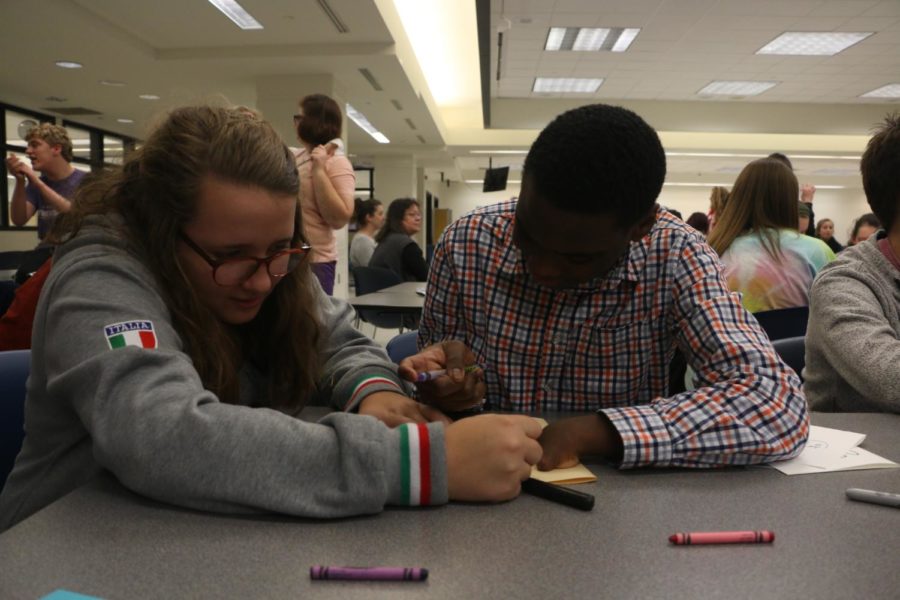Based on the New York Times bestseller, “Wonder,” a movie centered around the story of a boy named Auggie Pullman, who was born with a craniofacial condition, premieres in theatres today. The story follows 10-year-old Auggie as he navigates his way through his first year at public school.
Although he is a fictional character, Auggie represents a number of real life children born with craniofacial conditions. According to the National Craniofacial Association, one in every 650 babies born in the United States has a disorder affecting their face, skull, and/or neck. Also, the Children’s Craniofacial Association lists 19 conditions that classify as craniofacial disorders. Despite these numbers, though, “Wonder” is one of the few movies that addresses facial deformities.
Laurel Hullett, Best Buddies member and senior, the media’s portrayal of people with all types of physical and intellectual disabilities indicates an important shift in the way students perceive and treat students with special needs.
“I think (‘Wonder’) will make students at CHS pay more attention to the way that students treat kids with special needs. In both ways it will show them not to bully them and also teach them to not baby them, and just treat them like normal human beings because that is who they are,” Hullett said.
According to the Indiana Department of Education, CHS enrolls around 430 students who classify as special education students, which comprises about 8.6 percent of the student body. Beyond just differing curriculums, CHS offers various inclusive clubs, such as Best Buddies, Unified Sports and United Sound in which students with and without special needs participate. Hullett attributes her hands-on experiences in such clubs to exposing her to the proper way to treat those with special needs.
“I feel like all of my experiences opens my eyes to a whole new world. I never knew there was a different way to treat kids with special needs; I just always knew they were my friends and I can talk to them like anybody else,” Hullett said. “I think it’s a good thing that the media is shining a light on the way kids with special needs are treated, and it teaches kids who might not have experiences like mine how to act around students with special needs.”
According to Karen Hayes, Unified Bocce and Track sponsor, the increase in awareness regarding positive treatment towards people with special needs starkly contrasts attitudes 20 years ago.
“When I was growing up, children with disabilities did not go to our school, so I had no exposure to people with special needs. Because of that, it was very hard to know how to interact with people with special needs,” Hayes said. “Now, Carmel High School kids have grown up with kids with disabilities and kids are becoming more accustomed to kids of all abilities.”
According to Hayes, it’s important that the media portray people with all types of physical and intellectual disabilities in a positive manner.
Hayes said, “I think that the more media talks about kids with special needs and makes positive stories, the more accepting people will become.”

































![AI in films like "The Brutalist" is convenient, but shouldn’t take priority [opinion]](https://hilite.org/wp-content/uploads/2025/02/catherine-cover-1200x471.jpg)









































![Review: “The Immortal Soul Salvage Yard:” A criminally underrated poetry collection [MUSE]](https://hilite.org/wp-content/uploads/2025/03/71cju6TvqmL._AC_UF10001000_QL80_.jpg)
![Review: "Dog Man" is Unapologetically Chaotic [MUSE]](https://hilite.org/wp-content/uploads/2025/03/dogman-1200x700.jpg)
![Review: "Ne Zha 2": The WeChat family reunion I didn’t know I needed [MUSE]](https://hilite.org/wp-content/uploads/2025/03/unnamed-4.png)
![Review in Print: Maripaz Villar brings a delightfully unique style to the world of WEBTOON [MUSE]](https://hilite.org/wp-content/uploads/2023/12/maripazcover-1200x960.jpg)
![Review: “The Sword of Kaigen” is a masterpiece [MUSE]](https://hilite.org/wp-content/uploads/2023/11/Screenshot-2023-11-26-201051.png)
![Review: Gateron Oil Kings, great linear switches, okay price [MUSE]](https://hilite.org/wp-content/uploads/2023/11/Screenshot-2023-11-26-200553.png)
![Review: “A Haunting in Venice” is a significant improvement from other Agatha Christie adaptations [MUSE]](https://hilite.org/wp-content/uploads/2023/11/e7ee2938a6d422669771bce6d8088521.jpg)
![Review: A Thanksgiving story from elementary school, still just as interesting [MUSE]](https://hilite.org/wp-content/uploads/2023/11/Screenshot-2023-11-26-195514-987x1200.png)
![Review: "When I Fly Towards You", cute, uplifting youth drama [MUSE]](https://hilite.org/wp-content/uploads/2023/09/When-I-Fly-Towards-You-Chinese-drama.png)
![Postcards from Muse: Hawaii Travel Diary [MUSE]](https://hilite.org/wp-content/uploads/2023/09/My-project-1-1200x1200.jpg)
![Review: "Ladybug & Cat Noir: The Movie," departure from original show [MUSE]](https://hilite.org/wp-content/uploads/2023/09/Ladybug__Cat_Noir_-_The_Movie_poster.jpg)
![Review in Print: "Hidden Love" is the cute, uplifting drama everyone needs [MUSE]](https://hilite.org/wp-content/uploads/2023/09/hiddenlovecover-e1693597208225-1030x1200.png)
![Review in Print: "Heartstopper" is the heartwarming queer romance we all need [MUSE]](https://hilite.org/wp-content/uploads/2023/08/museheartstoppercover-1200x654.png)




